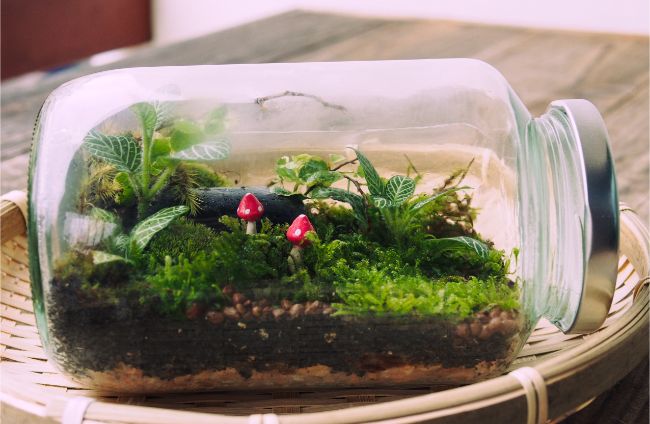Closed terrariums create a beautiful and fascinating ecosystem that will look fantastic in your home. They’re fairly easy to set up and maintain – as long as you choose the right plants. This article will help you choose the most beautiful and best closed terrarium plants.
What are the best closed terrarium plants? These 14 plants are ideal for a closed terrarium;
- Peperomia
- Pilea
- Nerve plant
- Mosses
- Selaginella
- Lemon button fern
- Maidenhair fern
- English Ivy
- Baby Tears Plant
- Creeping fig
- Polka dot plant
- Golden pothos
- Miniature phalaenopsis orchid
- Spider plant
This article discusses the 14 best plants for closed terrariums, providing you with a bit of information about each type of plant and the reasons why those plants or specific species in that plant group are well suited for closed terrariums. If you’d like to get started with a perfect selection of plants for your closed terrarium, you can’t go wrong with these.
What Type Of Plants Are Suited To A Closed Terrarium?
A closed terrarium creates a self-sufficient micro-environment that’s consistently warm and moist, so select plants that love warmth and humidity. For a truly low-maintenance closed terrarium, choose slower-growing plants that will remain small and that all have similar lighting requirements.
The plants highlighted here are mostly plants that thrive in medium to bright indirect sunlight; so if you group together plants that all share similar lighting preferences, you can locate your terrarium in a spot that receives the right lighting for those plants. In a properly constructed closed terrarium, you won’t need to water the plantsvery often, if at all, since the moisture constantly circulates through the closed system.
It’s important to recognize that articles recommending plants for generic terrariums will often list plants such as succulents that are suitable for open containers without mentioning that these plants will not do well in closed ones.
Peperomias
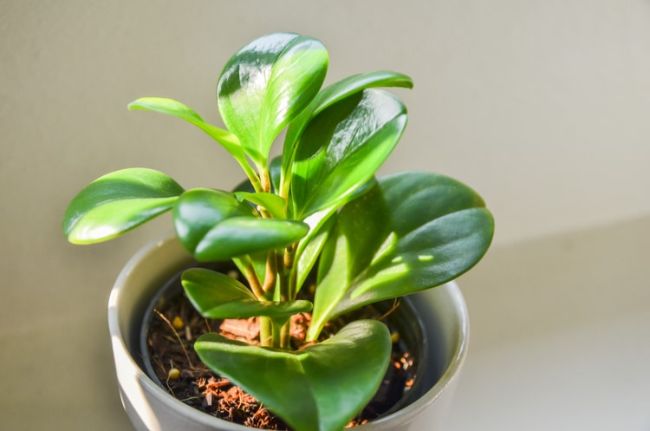
The Peperomia genus contains mostly small, compact plants that grow epiphytically on rotting wood in their natural habitats, usually gaining a height of no more than about 12 inches (30 cm). They are found mainly in tropical and subtropical areas of Central and South America.
While varying widely in size, shape, and color patterns, peperomia leaves are generally thick, fleshy, and smooth. Like most tropical rainforest floor plants, they thrive in lighting conditions ranging from full shade to bright indirect sunlight.
Perhaps the most popular peperomia species for closed terrariums is the emerald ripple peperomia (Peperomia caperata), since it will only grow to a height of 3-6 inches (8-15 cm). As the name suggests, this plant’s attractive heart-shaped leaves are emerald green with deep ripples that offer interesting textural variety to any terrarium plant arrangement.
The oval leaf peperomia (Peperomia obtusifolia) is another excellent choice for a closed terrarium. Growing a bit larger than the emerald ripple peperomia, this plant lives up to its name with its cupped oval-shaped leaves.
And its other common name of baby rubber plant is also fitting due to the thick, leathery, bright green appearance of the foliage.To maintain that vibrant green color, make sure the plant gets plenty of bright filtered or indirect light.
Growing to a height of just 8 inches (20 cm), watermelon peperomia (Peperomia argyreia) also has cupped oval-shaped leaves,but they stand out by being accented with striking silver stripes and bright red stems.
Learn more about peperomia houseplant care here.
Pileas
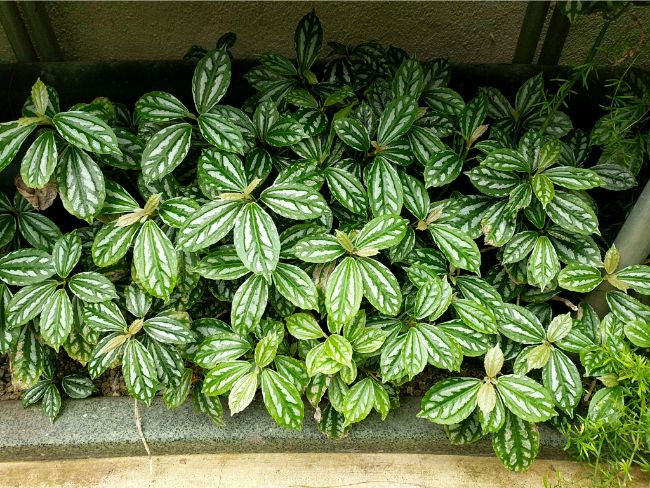
Pileas are a genus of tropical plant in the Urticaceae (nettle) family, and there are several species that are cultivated as houseplants that are also perfect for closed terrariums due to their small size, their need for high humidity, and their elegant foliage, along with their versatility regarding lighting conditions and easy care.
The genus name Pilea comes from the Latin word for “felt cap,” which describes the plant’s flower calyx. However, as with most other terrarium plants, the interesting leaf colors and textures far outshine the blooms, in addition to the fact that the plants rarely flower in indoor settings.
Originating from the jungles of Vietnam, aluminum plants (Pilea cadierei) have toothed, dark green leaves with raised patches of shimmery metallic silver that give rise to their common name, and the dwarf Minima cultivar is a compact plant that grows to a maximum of just 6 inches (15 cm) in height.
Read my guide to caring for aluminum plants here.
The friendship plant (Pilea involucrata) is another type of pilea that’s very popular for use in closed terrariums. This bushy trailing plant that hails from Central and South America features clusters of lovely textured leaves of green with deep bronze undertones framed by light green margins.
The Dark Mystery pilea is a variety of this species that has elongated leaves with a unique chocolate-brown color accented by contrasting silver stripes running down the center veins. Its low, mounding growing habit makes it a particularly good choice of pilea for a closed terrarium.
And then there’s the Moon Valley pilea (Pileamollis). According to the Missouri Botanical Garden Plant Finder, this variety of pilea is often sold as Pilea involucrata, and its foliage has a similar color pattern to that species, although the soft, velvety texture that characterizes Pilea mollis sets it apart.
In fact, the specific species name of mollis means “soft” or “with soft hairs,” while the common name of this cultivar is inspired by the way the exaggerated vein texturing, combined with its otherworldly coloring, resembles the puckered surface of the moon.
Nerve Plant (Fittonia albivensis)
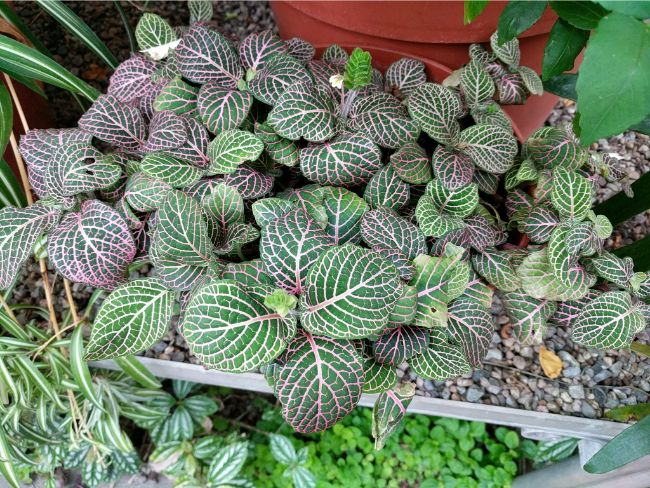
Nerve plants (Fittonia albivensis) are very colorful plants that are found on the floor of tropical rainforests in Peru and Colombia, and they enjoy warm temperatures, high humidity, and partial to full shade. The compact and dwarf cultivars of this species are popular selections for closed terrariums, where they serve as striking focal points.
Fittonias with common names such as nerve plant as well as mosaic plant and painted net leaf may have deep green foliage with bright red or intense pink veins, or their coloration may be reversed, such that the leaves are red, pink, or lavender with veins of deep green.
There are also fittonias with common names like silver net leaf and silver threads that feature vivid green foliage with intricate, strongly contrasting white veins.
Learn more about nerve plants and how to care for them here.
Mosses (Bryophytas)
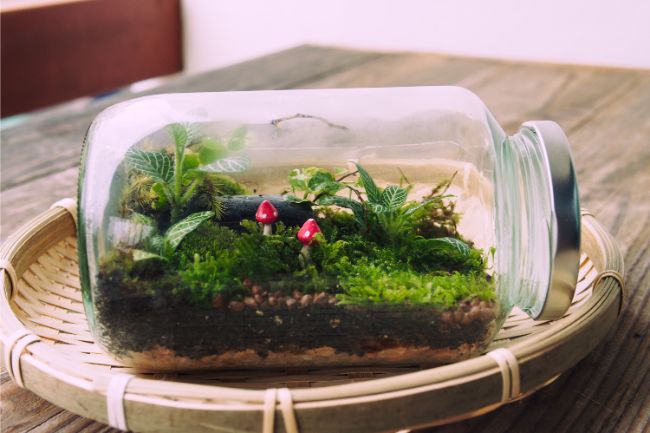
Mosses (bryophytas) are non-vascular plants (i.e., they don’t have the specialized tissues for delivering water and nutrients that most plants have) and they don’t grow roots.
Because of these unique characteristics, mosses absorb water primarily through their leaves, which usually consist of just a single layer of cells. This means that these small plants need to be constantly in contact with moisture.
Mosses are often used for ground cover in closed terrariums because they thrive in moist environments, they don’t take up much vertical space due to their low profile and lack of root systems, and they are very slow growers. Also, since mosses prefer full shade, they don’t mind being blocked by larger plant foliage in the tight confines of a terrarium.
Common types of moss that are sold for terrariums include live sphagnum, sheet, cushion, spoon, and hair cap mosses. With such a variety available, you can even create a captivating closed terrarium filled exclusively with different types of mosses, which you can set in a location that gets less light than would be necessary for most other types of plants.
Spike Mosses (Selaginellas)
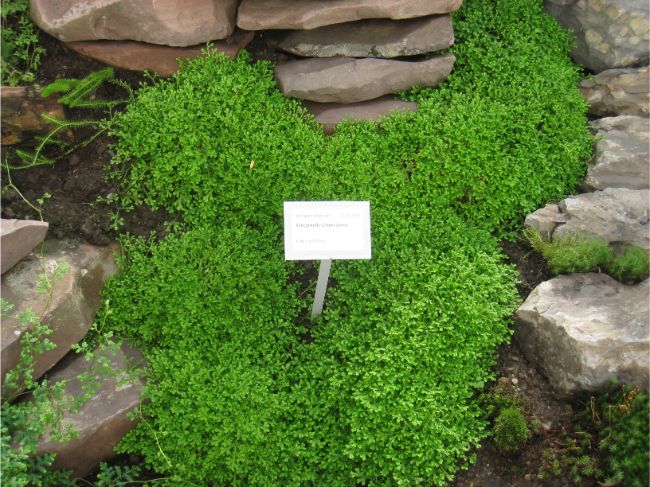
Spike mosses (selaginellas)are not actually mosses; but like mosses, they are moisture-loving plants that work great as closed terrarium plants, particularly as ground cover. They are small, very durable plants that come in a wide variety of colors, patterns, and textures.
Looking a lot like tiny ferns, spike mosses will create a lush carpet of feathery foliage for your closed terrarium. And indeed, selaginellas are very similar to ferns, both in structure and by virtue of producing spores. With most species originating in the tropics, they are also similar to ferns in that they are found on the floor of the rainforest, so they do best in partial to full shade.
Small Ferns
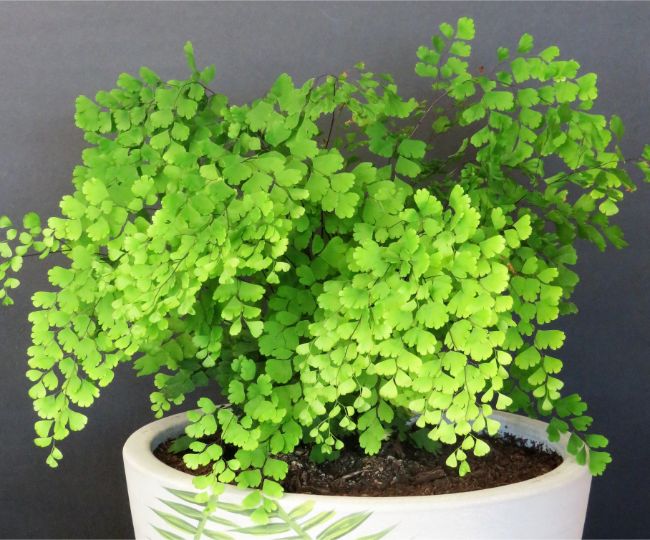
Speaking of ferns, these plumy plants are well suited to the warm, moist environment of a closed terrarium, and there are several small varieties that make excellent additions to this type of miniature greenhouse.
The best ferns to use for these enclosures are slow-growing varieties that reach between 6 and 12 inches (15-30 cm) at maturity. By occasionally pruning or pinching off new growth, you can keep ferns as well as other plants tidy and encourage them to grow fuller instead of becoming unruly or leggy.
One of the most popular small ferns for closed terrariums, as well as for use as regular houseplants, is the easy-to-grow lemon button fern (Nephrolepis cordifolia). This adorable little plant is the smallest type of Boston fern, and it features arching stems with alternating small, round leaflets. Lemon button ferns prefer medium to bright filtered sunlight.
Note that there is another type of fern, Pallaea rotundifolia, that goes by the common name of button fern, but it is quite different from the lemon button fern and is not as suitable for closed terrariums.
Adiantums are a genus of ferns that are popular for closed terrariums, as well, since they love warmth, moisture, and full shade to filtered sunlight. Known by the common name of maidenhair fern, they have distinctive black stems and lacy, bright green leaflets that will turn your enclosed garden into a magical fairyland.
The southern maidenhair fern (Adiantum capillus-veneris) is a small fern belonging to this genus that grows fairly slowly. It is native to the southern United States and tropical areas to the south. This dainty fern is also known as the Venus hair fern.
Another popular species of adiantum that tends to thrive in closed terrariums is the delta maidenhair fern (Adiantum raddianum). Native to the tropical Americas and West Indies, this fern has delicate leaflets with an appealing lacy outline.
However, be aware that because it’s faster growing, you’ll have to stay on top of the pruning of this plant, so it isn’t the best choice if your aim is to create a self-sufficient,very low-maintenance terrarium.
Miniature English Ivy (Hedera helix)
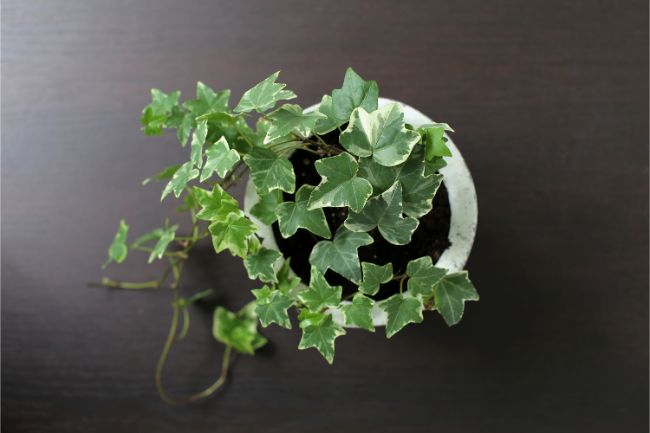
English ivy (Hedera helix), or common ivy, may not at first seem like a good choice of closed terrarium plant, but the miniature version of this hardy vine is a petite, easy-to-grow plant that takes the warm, moist, environment of a closed container in stride – as long as it doesn’t get too much light.
It offers a look that’s more familiar than the exotic tropical plants that are typically found in these container gardens. Also, you might be surprised to learn that common ivy grows less vigorously than other types of ivy.
Hedera helix has pretty, somewhat lobed, heart-shaped leaves, and the miniature version comes in a variety of variegated colors and patterns. The vine will creep across the ground and can serve as ground cover, or it can be allowed to climb, to provide some vertical greenery that can serve as an accent to other plant shapes and sizes.
Baby’s Tears (Soleirolia soleirolii)

Another member of the Urticaceae family that’s native to the area of the Mediterranean around Italy, baby’s tears (Soleirolia soleirolii) is a ground cover plant that loves warmth, moisture, and medium to bright indirect sunlight. Other common names for this plant include angel’s tears, friendship plant, Corsican creeper, helxine, mother of thousands, and Paddy’s wig.
The baby’s tears’ small, delicate-looking, yellowish to bright green leaves bring a sunny warmth to any terrarium arrangement. However, it’s a faster-growing plant, and it is also capable of vegetative propagation, which means it has the ability to reproduce asexually using a part of the existing plant.
Together, these factors make baby’s tears a less desirable choice for those who want to set up a truly low-maintenance closed terrarium. If you decide to use baby’s tears in this type of setting, be prepared to manage it by pruning, so it doesn’t overtake the limited space inside your terrarium.
Creeping Fig (Ficus pumila)
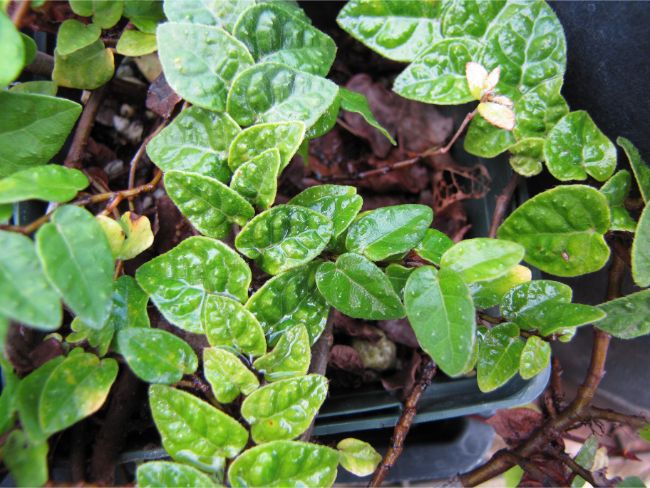
The creeping fig (Ficus pumila) is a small ficus (also known as a fig plant) that hails from tropical East Asia and thrives in warm, moist environments. It grows as dense ground cover or as a climbing vine, having aerial roots that secrete a latex glue that allows the plant to cling to its supports.
The species name pumila is related to the Latin word for “dwarf,” in reference to the plant’s very small but thick leaves. This foliage may be solid green or variegated in a range of patterns and textures. So the creeping fig can serve as an alternative to miniature English ivy, if you prefer to have a more dainty looking vining plant.
While this hardy little plant is often fast growing, look for varieties of Ficus pumila such as the Bellus, which has white-edged leaves, as well as Curly and Dorty creeping figs that have a medium growth rate, making them more suitable closed terrarium plants.
Polka Dot Plant (Hypoestes phyllostachya)
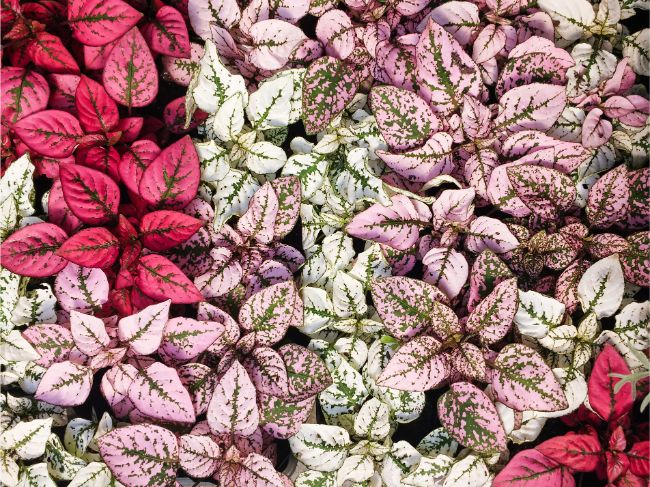
Add a splash of cheer to your closed terrarium with the polka dot plant (Hypoestes phyllostachya), a delightful little plant that features pretty, spotted pink, purple, red, or white on green leaves. This warmth and moisture loving plant craves medium to bright, indirect lighting and will become leggy and weakened if it doesn’t get enough light. Another sign that it isn’t getting enough light is loss of its polka dots.
As with the golden pothos, polka dot plants tend to be vigorous growers, so you will likely need to pinch back the new growth to encourage the plant to remain fuller and more compact. The Confetti polka dot plant is a small variety, growing up to 8 inches (20 cm) in size.
Learn more about caring for the polka dot plant here.
Golden Pothos (Epipremnum aureum)
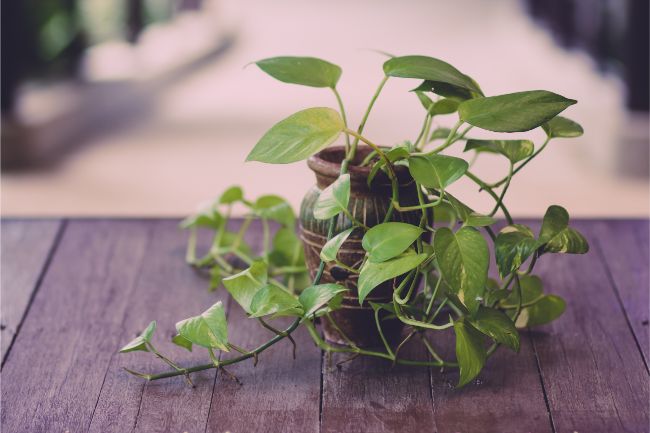
The golden pothos (Epipremnum aureum) is a climbing or trailing plant that looks much like a small philodendron, with its vining stems and heart-shaped leaves.
The common name golden pothos refers to the yellow variegation that is often seen on the foliage, although these plants may also have cream-colored or white marbling. Alternate common names for Epipremnum aureum include devil’s ivy, ivy arum, Solomon Island ivy, and simply pothos.
Golden pothos are very popular houseplants because they are known to be nearly indestructible, and in fact, the biggest concern you are likely to have with this plant in a closed terrarium is keeping it pruned back so it doesn’t become too unruly.
While this plant’s preferred growing conditions are warm temperatures, moderate to high humidity, and medium indirect lighting, golden pothos is an extraordinarily versatile plant that will tolerate a range of growing conditions.
Find more articles about golden pothos here.
Miniature Phalaenopsis Orchids
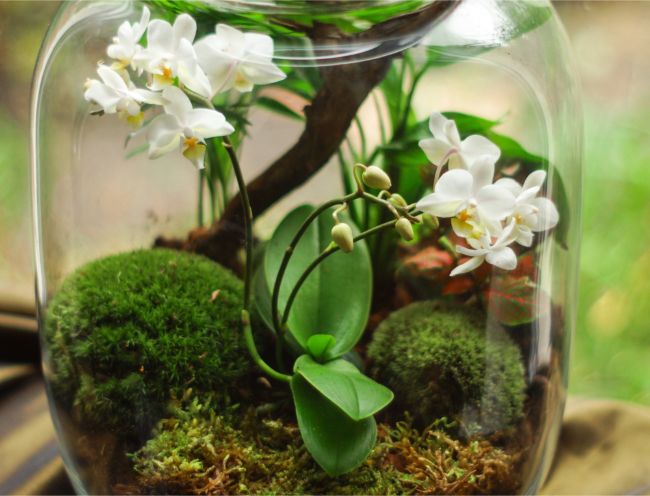
With stunning blooms that last for months, phalaenopsis orchids are an excellent choice to add some floral beauty to a closed terrarium. Preferring lower light and high humidity, they are a perfect choice for the micro-climate within a closed terrarium.
Depending on the size of your terrarium, the miniature varieties are likely to be most suitable and there are a multitude of bloom colors to choose from.
Caring for phalaenopsis orchids is remarkably easy as long as you avoid overwatering them. I’ve written extensively about how to care for phalaenopsis orchids in other articles on this site.
- How to care for phalaenopsis orchids.
- How much light do phalaenopsis orchids need?
- How to water phalaenopsis orchids.
Spider Plant (Chlorophytum comosum)
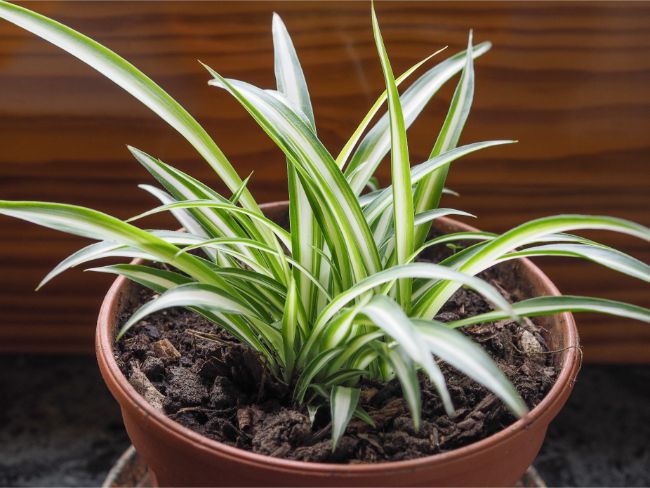
With its long, narrow, green and white striped leaves and its ability to grow new plantlets at the end of long stems known as inflorescences, the spider plant (Chlorophytum comosum) rounds out our list of the best plants for closed terrariums due to its love of high humidity and its easy-to-care-for nature.
It’s another popular houseplant that is adaptable to a variety of growing conditions. So while the spider plant prefers bright indirect light, it tolerates low lighting. And although it likes to be watered when its soil is almost but not completely dry, it can handle more consistent soil moisture, as long as the soil has good drainage and doesn’t remain soggy – a condition that is essential for all plants in a closed terrarium to avoid root rot.
The Variegatum cultivar is a smaller version and therefore the most suitable type of spider plant for growing in a closed terrarium. It has attractive medium to dark green leaves with white bands at the margins.
You’ll want to keep an eye out for those little plantlets and remove them from the terrarium before they take over the whole thing. You can always plant them in pots and decorate the rest of your home or give them away to friends!
Further reading about caring for spider plants:
Why Does My Spider Plant Have Brown Tips?
Why Is My Spider Plant Dying? (And How To Fix It)
Last Word
I hope you’ve enjoyed reading about these 14 plants that are ideal for closed terrariums. I’ve really enjoyed building and looking after my terrarium and hopefully this article will help you with yours.
There are so many different terrarium to choose from, ranging from very affordable and practical, to quite expensive but stunning. I’ve used the first option below to build a really successful terrarium. The second option is my dream terrarium to get some time in the future.

If you really want to go all out with building a closed terrarium, the BiOrb Air is amazing. It controls humidity and watering for you, has integrated lighting and just looks so awesome.


